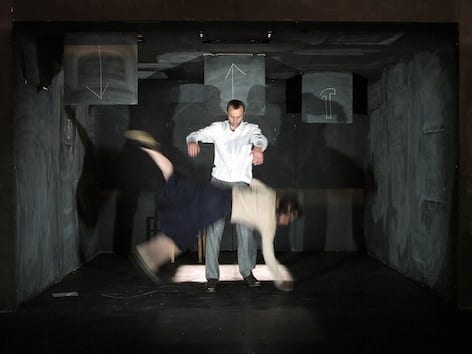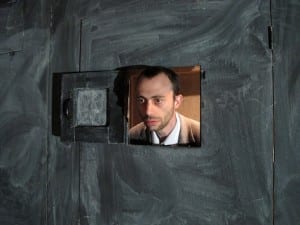Recklessly Undefinitive?
Last month our very own LPAC hosted a performance by the established contemporary theatre company, Reckless Sleepers. It was a re-devised piece of one of their ‘most celebrated performance pieces’ and was described by the company on their website as “a visually mesmerising performance that sways between question and answer, chaos and order, what we can measure and what we can’t.” entitled Shrödinger. Knowing the relevance of this company’s work to multi-media and contemporary performance, I attended the show.
With a month to reflect on the event, I can now describe my feelings on the show and its relevance to our devising process. But first a brief description of what was involved from The Times reporter, Donald Hutera:
The set is a huge box constructed out of chalkboard, upon which the five-strong cast scribble and draw, and which has trapdoors on all sides, into and out of which they slither or pop. The intermittent spoken text is drily clinical, sometimes based on numerical patterns, or patently contradictory. The props are functional — tables and chairs and, later, many bottles of water that are either guzzled down or used by individuals to furiously wash away the markings that others make.
Strange things occur as a result of people behaving in a furtive, potentially violent and yet cyclical manner, and most actions are usually not what they might at first seem. A man drops through a ceiling and someone immediately traces the body as if in a crime scene. There are allusions to magic when a cloth is pulled from under a bottle on a table and, later, a suit coat from beneath a woman’s feet. Two men repeatedly exchange hammer and briefcase in a threatening game of keep-away. A couple whose heads are swaddled in sheets are yanked apart before they can embrace. It climaxes in an extended scene of watery chaos.
It sounds chaotic and ridiculous, and it was. My initial feeling after watching it was shock and confusion: ‘What just happened?’. With a fear of the unknown creeping into my mind, I was at first fairly unimpressed with the sheer disparity of some of the action. It felt slightly pointless and pretentious to me, and like a lot of audiences of contemporary art I saw it as something just for the sake of it, with no clear message.
However. In hindsight and with further reading into the context, I see the point. For a lot contemporary work, that is the point, it’s not handed to you on a silver platter and you can make of it what you will. It’s just as much about the spectator as it is the work itself. What I make of it now, is that it was visually spectacular, foreign and interesting, punctuated with little pleasant surprises for instance by repeating certain gestures, sounds, images and then breaking the cycle.
Near the beginning of the piece it is established that,
It may seem to you that we’ve done this for the first time […] even the mistakes have been repeated over and over to get them exactly right. She looks like she doesn’t know what to do next. Of course she knows what she’ll do next, it is never different. Nothing is left to chance; nothing can go wrong, we’ve thought of every eventuality
(Wetherell, 2011: 3 cited by Westerside, 2011)
This statement leaves you challenging the truth in it, especially as in the performance I was certain I spotted a truly accidental mistake as one performer yelled out a numerical sequence which was then desperately noted down on a black wall by another, and he missed a number. Did he really miss the 2 on purpose as they might want us to believe? Or are they only human? Error comes with the territory…
HOW IS IT RELEVANT?
The things that I hated about Shrödinger, ended up being the very things I liked. The open-endedness, the playfulness of the performance in the constructed space, the visual, the architecture of it (they played with audience perspective), the sensual (I loved the accompanying music). This is something to bear in mind as we devise; are we trying to convey a certain message, or are we just playing with themes and ideas in a space (Toyko). And if we leave it too open-ended, will our audience just hate it? And do we care? These are all questions which we need to ask ourselves in the next four weeks.
this is exactly what we’re supposed to be doing as performance makers that think about what performance can and might be. The performance space is unknown until we engage with it, until we put properties inside it and see how they react. We don’t know until we look.
(Westerside, 2011)
References:
Hutera, Donald (2011) Schrodinger at the Arnolfini, Bristol. Available online @ http://www.reckless-sleepers.co.uk/press/22/Schrodinger%20at%20the%20Arnolfini.pdf [accessed 12/4/12]
Westerside, Andrew (2011) Peer review. Available online @ http://www.reckless-sleepers.co.uk/press/22/Reckless%20Sleepers%20-%20Schrodinger%20-%20A4%20Peer%20Review.pdf [accessed 12/4/12]
Shrödinger by Reckless Sleepers website: http://www.reckless-sleepers.co.uk/project.php?id=22
By Sylvia Entwistle.

